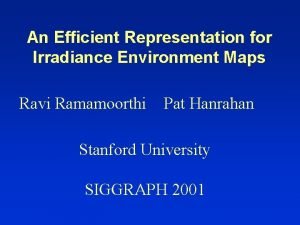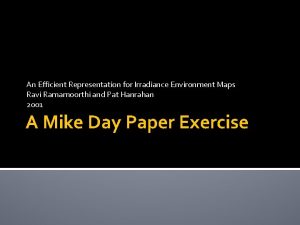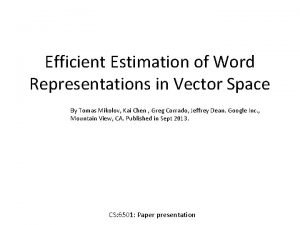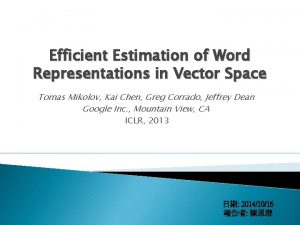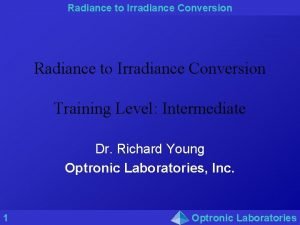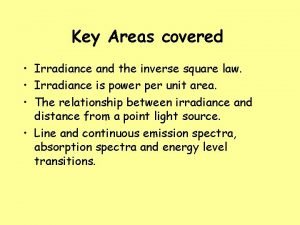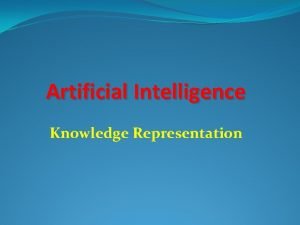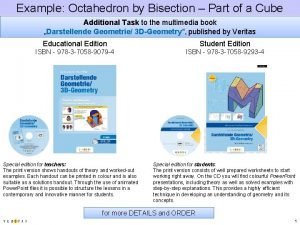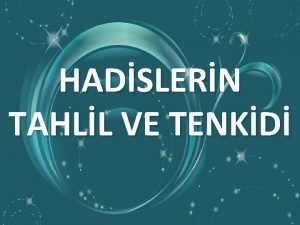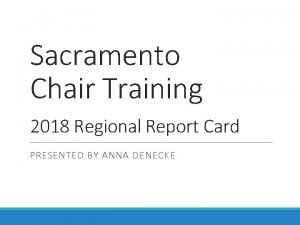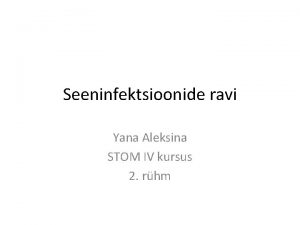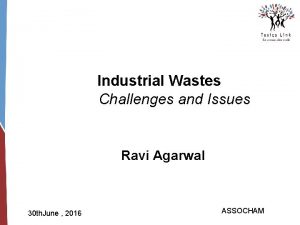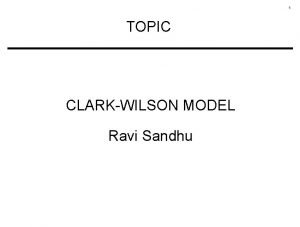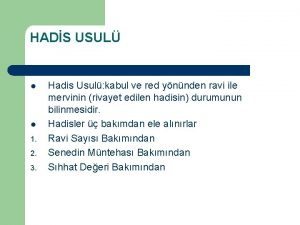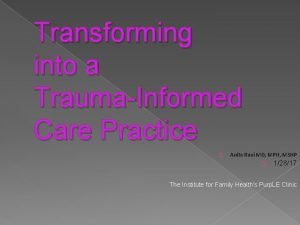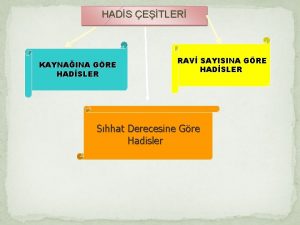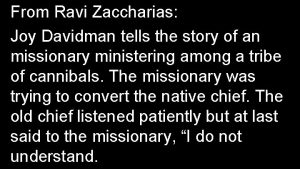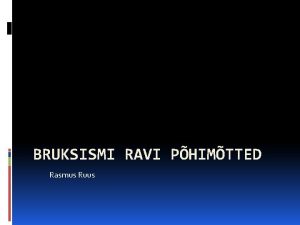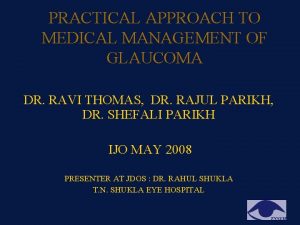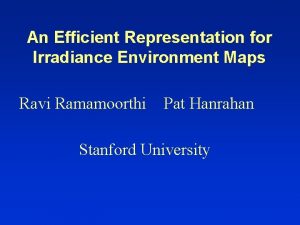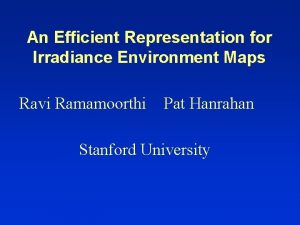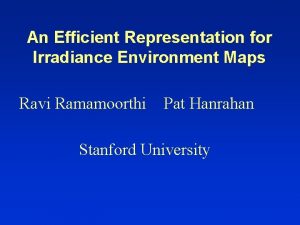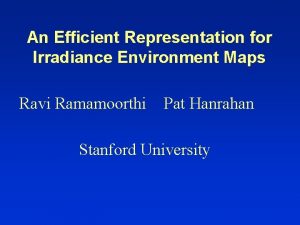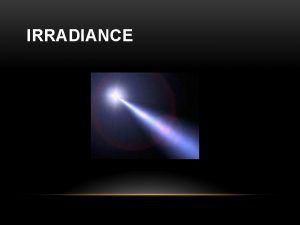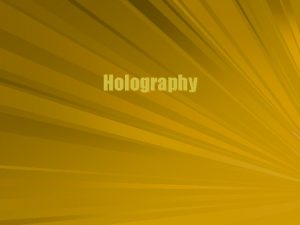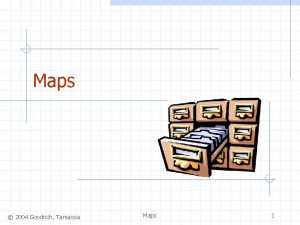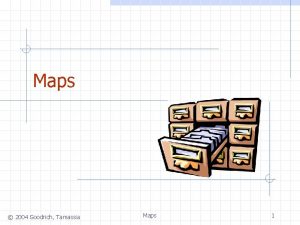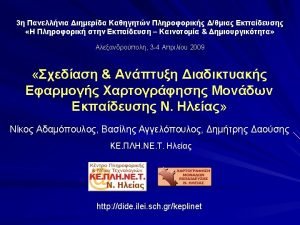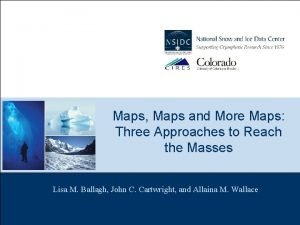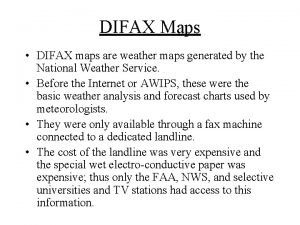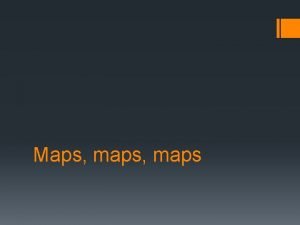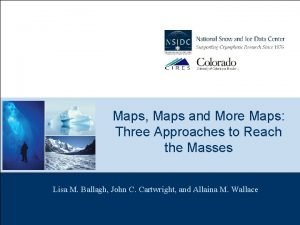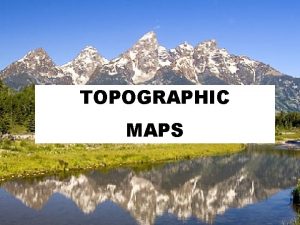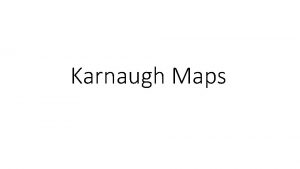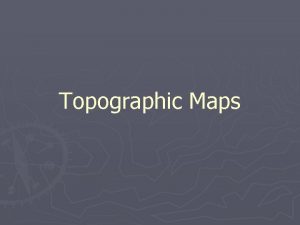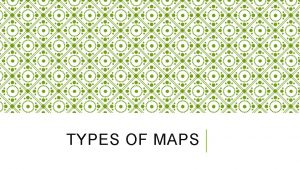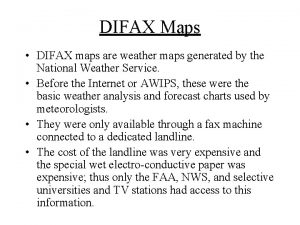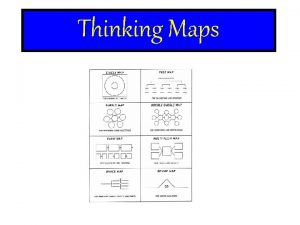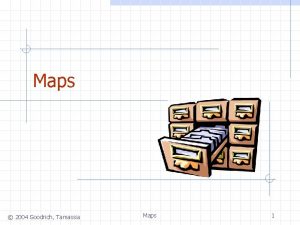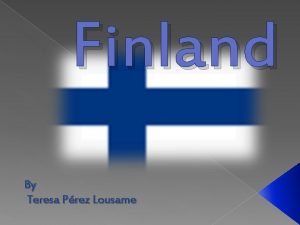An Efficient Representation for Irradiance Environment Maps Ravi









![New Theoretical Results Analytic Irradiance Formula [Ramamoorthi Hanrahan 01, Basri Jacobs 01] • Expand New Theoretical Results Analytic Irradiance Formula [Ramamoorthi Hanrahan 01, Basri Jacobs 01] • Expand](https://slidetodoc.com/presentation_image_h2/1d8dd5575bdff08b51fb3c794cae9b55/image-10.jpg)




















- Slides: 30

An Efficient Representation for Irradiance Environment Maps Ravi Ramamoorthi Pat Hanrahan Stanford University

Natural Illumination People perceive materials more easily under natural illumination than simplified illumination. Images courtesy Ron Dror and Ted Adelson

Natural Illumination Classically, rendering with natural illumination is very expensive compared to using simplified illumination Directional Source Natural Illumination

Reflection Maps Blinn and Newell, 1976

Environment Maps Miller and Hoffman, 1984

Irradiance Environment Maps R Incident Radiance (Illumination Environment Map) N Irradiance Environment Map

Assumptions • Diffuse surfaces • Distant illumination • No shadowing, interreflection Hence, Irradiance is a function of surface normal

Diffuse Reflection Reflectance (albedo/texture) Radiosity (image intensity) = Irradiance (incoming light) × quake light map

Previous Work • Precomputed (prefiltered) Irradiance maps [Miller and Hoffman 84, Greene 86, Cabral et al 87] • Irradiance volumes [Greger et al 98] • Global illumination [Wilkie et al 00] Empirical: Irradiance varies slowly with surface normal • Low resolution Irradiance maps • Irradiance gradients [Ward 92]
![New Theoretical Results Analytic Irradiance Formula Ramamoorthi Hanrahan 01 Basri Jacobs 01 Expand New Theoretical Results Analytic Irradiance Formula [Ramamoorthi Hanrahan 01, Basri Jacobs 01] • Expand](https://slidetodoc.com/presentation_image_h2/1d8dd5575bdff08b51fb3c794cae9b55/image-10.jpg)
New Theoretical Results Analytic Irradiance Formula [Ramamoorthi Hanrahan 01, Basri Jacobs 01] • Expand Radiance, Irradiance in basis functions • Analytic formula for Irradiance coefficients Key Results • Irradiance approx. for all normals using 9 numbers • Can be computed as quadratic polynomial

Contributions • Theory: frequency domain analysis • Efficient computation of Irradiance • Procedural rendering algorithm (no textures) • New representation: apply to lighting design

Computing Irradiance • Classically, hemispherical integral for each pixel Incident Radiance • Lambertian surface is like low pass filter • Frequency-space analysis Irradiance

Spherical Harmonics 0 1 2. . . -2 -1 0 1 2

Spherical Harmonic Expansion Expand lighting (L), irradiance (E) in basis functions =. 67 +. 36 + …

Analytic Irradiance Formula Lambertian surface acts like low-pass filter 0 0 1 2

9 Parameter Approximation Order 0 1 term Exact image RMS error = 25 % 0 1 2 -2 -1 0 1 2

9 Parameter Approximation Order 1 4 terms Exact image RMS Error = 8% 0 1 2 -2 -1 0 1 2

9 Parameter Approximation Order 2 9 terms Exact image RMS Error = 1% For any illumination, average error < 3% [Basri Jacobs 01] 0 1 2 -2 -1 0 1 2

Computing Light Coefficients Compute 9 lighting coefficients Llm • 9 numbers instead of integrals for every pixel • Lighting coefficients are moments of lighting • Weighted sum of pixels in the environment map

Comparison Incident illumination 300 x 300 Irradiance map Texture: 256 x 256 Hemispherical Integration 2 Hrs Irradiance map Texture: 256 x 256 Spherical Harmonic Coefficients 1 sec

Rendering Irradiance approximated by quadratic polynomial 4 x 4 matrix (depends linearly on coefficients Llm) Surface Normal vector column 4 -vector

Hardware Implementation Simple procedural rendering method (no textures) • Requires only matrix-vector multiply and dot-product • In software or NVIDIA vertex programming hardware

Complex Geometry Assume no shadowing: Simply use surface normal

Lighting Design Final image sum of 3 D basis functions scaled by Llm Alter appearance by changing weights of basis functions

Demo

Summary Theory • • Analytic formula for irradiance Frequency-space: Spherical Harmonics To order 2, constant, linear, quadratic polynomials 9 coefficients (up to order 2) suffice Practical Applications • Efficient computation of irradiance • Simple procedural rendering • New representation, many applications

Implications and Future Work 9 parameter model important in other areas • Inverse Rendering (Wednesday) [SIGGRAPH 01] • Lighting variability object recognition [CVPR 01] Frequency space for rendering • Environment maps with general BRDFs? • Applications to offline rendering? http: //graphics. stanford. edu/papers/envmap/ Source code, examples, links to theory paper, …

Acknowledgements • Stanford Real-Time Programmable Shading System • Kekoa Proudfoot, Bill Mark • Readers of early drafts • Bill Mark, Kekoa Proudfoot, Sean Anderson, David Koller, Ron Dror, anonymous reviewers • Models • Armadillo: Venkat Krishnamurthy • Light probes: Paul Debevec • Funding • Hodgson-Reed Stanford Graduate Fellowship • NSF ITR #0085864 “Interacting with the Visual World”

The End

Compare to Point Sources Irradiance Map Texture Quadratic Polynomial 6 Directional Light sources Note Mach Banding
 Irradiance environment map
Irradiance environment map An efficient representation for irradiance environment maps
An efficient representation for irradiance environment maps C b a d
C b a d Productively efficient vs allocatively efficient
Productively efficient vs allocatively efficient Productively efficient vs allocatively efficient
Productively efficient vs allocatively efficient Productively efficient vs allocatively efficient
Productively efficient vs allocatively efficient Allocative efficiency
Allocative efficiency Efficient estimation of word representations
Efficient estimation of word representations Efficient estimation of word representations
Efficient estimation of word representations Global illumination vray
Global illumination vray Radiance to irradiance conversion
Radiance to irradiance conversion Inverse square law irradiance
Inverse square law irradiance The backward representation mapping maps from to facts.
The backward representation mapping maps from to facts. Google map reittihaku
Google map reittihaku Octahedron environment maps
Octahedron environment maps Environment of business finance
Environment of business finance Senet tenkidinde ölçütler
Senet tenkidinde ölçütler Ravi patki
Ravi patki Ravi kumar sacramento
Ravi kumar sacramento Ravi credit card
Ravi credit card Dermatofüütia
Dermatofüütia Ravi agarwal md
Ravi agarwal md Dr ravi sandhu
Dr ravi sandhu Ravi zinciri örneği
Ravi zinciri örneği 4 r's trauma informed care
4 r's trauma informed care Ravi sayısına göre hadis çeşitleri
Ravi sayısına göre hadis çeşitleri Class 7 english a gift of chappals lesson plan
Class 7 english a gift of chappals lesson plan Ravi zaccharias
Ravi zaccharias Bruksism
Bruksism Ravi and minu architects
Ravi and minu architects Indentation gonioscopy
Indentation gonioscopy
